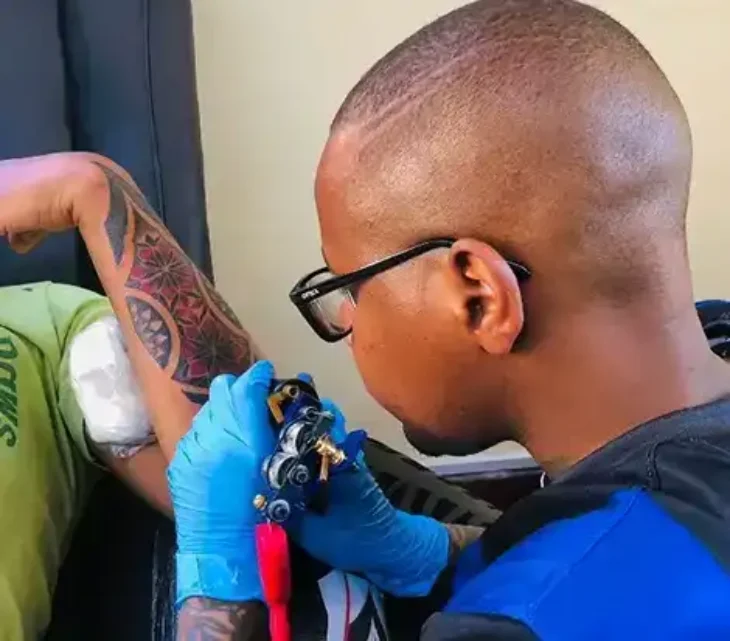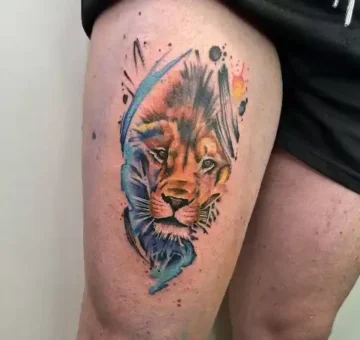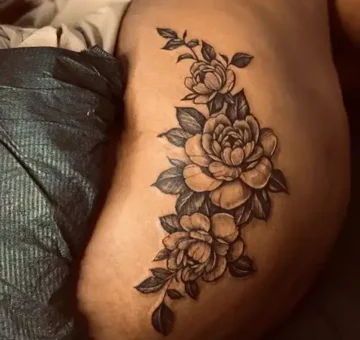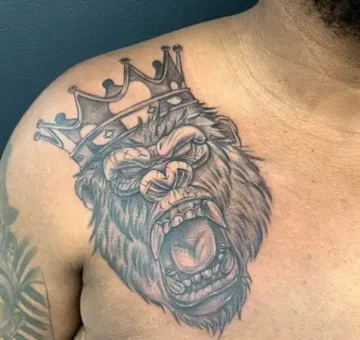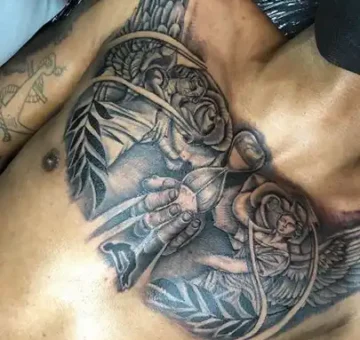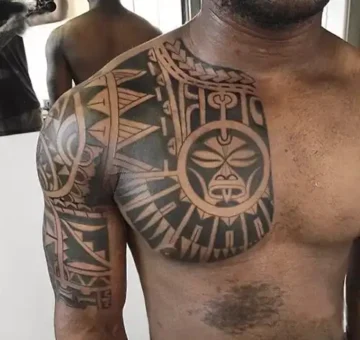Best Permanent Tattoos Parlour in Nairobi, Kenya
Welcome to Rebel Inks Tattoos, Tattoo Removal, and Body Piercings Parlour in Nairobi, Kenya, where art meets permanence! Our expert team of skilled tattoo artists is dedicated to transforming your creative vision into a lasting masterpiece on your skin. With a passion for precision and a commitment to excellence, we specialize in providing top-notch permanent tattoo services that go beyond mere ink and needles. Our studio boasts a diverse portfolio, showcasing a wide range of styles, from intricate black and gray designs to vibrant and colorful masterpieces.
Permanent Tattoos involve the use of ink or pigments to create a design on the skin that will remain there for an extended period, typically for a person’s lifetime.
In a world that’s constantly evolving, where trends come and go like fleeting gusts of wind, there’s one form of self-expression that endures through generations—permanent tattoos. These inked masterpieces on the canvas of our skin tell stories, convey emotions, and reveal the very essence of who we are.
A tattoo artist uses a machine with needles to puncture the skin’s top layer and inject ink into the dermis, the deeper layer of the skin. This ink becomes trapped in the dermis, which is why tattoos are difficult to remove.
Tattoo ink is specifically formulated for use on the skin. It contains various pigments and is available in a wide range of colors. The safety and quality of tattoo ink are essential to avoid infections and other complications.
At Rebel Inks Tattoos, Tattoo Removal, and Body Piercings Parlour in Nairobi, Kenya, we prioritize hygiene and safety, ensuring a clean and sterile environment for every client. Whether you’re looking to commemorate a special moment, express your individuality, or simply adorn yourself with striking body art, our talented artists are here to turn your dreams into reality. Explore the limitless possibilities of self-expression with our bespoke tattoo services. Join us at Rebel Inks Tattoos, Tattoo Removal, and Body Piercings Parlour and let us be the canvas for your story. Book your appointment today and experience the fusion of artistry and permanence that defines us as the premier destination for exceptional tattoos. Your journey to a lifelong work of art begins here!
Types of Permanent Tattoos we Offer
Pemanent Tattoo Designs
Considerations before getting a Permanent Tattoo
Getting a permanent tattoo is a significant decision that should be made after careful consideration. Here are several important considerations to take into account before getting a permanent tattoo:
- Design Choice: Select a design that has personal meaning to you. Tattoos are a form of self-expression, so choose something that reflects your identity, beliefs, or experiences. Avoid getting a tattoo on a whim or solely for trends.
- Tattoo Placement: Think about where you want the tattoo on your body. Consider visibility and how it may affect your personal or professional life. Some workplaces have strict policies on visible tattoos.
- Tattoo Artist: Research and choose a reputable and skilled tattoo artist. Read reviews, view their portfolio, and visit the studio to ensure cleanliness and professionalism. Don’t compromise on quality for the sake of cost.
- Hygiene and Safety: Ensure that the tattoo studio follows strict hygiene and safety standards. Needles should be single-use and sterile, and the artist should wear disposable gloves. This reduces the risk of infections and complications.
- Pain and Healing: Tattoos can be painful, and the healing process can be uncomfortable. Consider your pain tolerance and be prepared for a few weeks of aftercare, including keeping the tattoo clean, moisturized, and protected from the sun.
- Long-Term Commitment: Permanent Tattoos are designed to stay on your skin and body for an extended period of time. You need to be prepared to live with the tattoo for a long period of your life. However, if by any chance over the years your circumstances, situation or mood towards your tattoo changes you can Contact Us and schedule a Laser Tattoo Removal Session that will help get rid of the tattoo completely.
- Allergies and Reactions: Some people may be allergic to tattoo ink. Consider doing a patch test to ensure you don’t have an adverse reaction to the ink used in your tattoo.
- Cultural and Religious Significance: Be aware of the cultural and religious significance of tattoos in your community. In some cultures, tattoos may carry specific meanings or be discouraged.
- Consultation: Discuss your ideas and concerns with the tattoo artist. At Rebel Inks Tattoo Removal and Piercings Parlour we can offer valuable insights, help with design choices, and provide information on what’s feasible. Contact Us Today to learn more.
- Cost: Tattoos can be expensive, and the price may vary depending on the size and complexity of the design. Make sure you can afford the tattoo and any additional costs associated with aftercare.
- Life Changes: Consider how the tattoo may fit into your future. Life circumstances can change, and the tattoo should still be meaningful even as you grow older.
- Multiple Consultations: Don’t rush into a decision. At Rebel Inks Tattoo Removal and Piercings Parlour we offer pre-tattooing consultation services, this allows us and you as our client the opportunity to comfortably decide on the final design and placement.
- Tattoo Etiquette: Understand the etiquette surrounding tattoos, especially when it comes to showcasing your ink in different social or cultural settings. Be prepared for potential reactions from others.
- Legal Age: At Rebel Inks Tattoo Removal and Piercings Parlour we DO NOT offer our tattoo services to any one who is below the age of 18 years. Ensure you are of legal age to get a tattoo, which is typically 18 years or older.
Taking the time to consider these factors will help you make an informed decision about getting a permanent tattoo that you will be proud to wear for a lifetime. Remember that tattoos are deeply personal and should be a reflection of your individuality and experiences.
Schedule Appointment
Permanent Tattoo Process
The permanent tattoo process involves several steps, from selecting a design to the final inked result on your skin. Here is an overview of the typical process of getting a permanent tattoo:
- Design Selection: The process begins with choosing a design for your tattoo. This can be something personal, symbolic, or purely aesthetic. Many people opt for custom designs created by a tattoo artist, while others choose from existing designs or symbols.
- Tattoo Artist Selection: Research and choose a skilled and reputable tattoo artist or studio. Look at their portfolio to assess their style, see if they specialize in the type of design you want, and read reviews from previous clients. It’s crucial to find an artist who aligns with your vision and has a strong track record for safety and professionalism.
- Consultation: Schedule a consultation with the chosen tattoo artist. During this meeting, you’ll discuss your design ideas, placement, size, and any modifications. The artist may offer suggestions to ensure the tattoo will work well on your chosen body part.
- Design Finalization: Collaborate with the artist to refine and finalize the design. They may create a sketch or digital representation of the tattoo, allowing you to see how it will look on your skin. This is the time to make any last-minute changes.
- Consent Form: Before the tattooing process begins, you’ll typically be asked to sign a consent form acknowledging that you understand the risks and have agreed to the design.
- Preparation: Your tattoo artist will clean and sterilize the area where the tattoo will be applied. They’ll then shave the area to ensure a smooth canvas for the ink.
- Stencil Application: Using a stencil or a freehand technique, the artist will transfer the design onto your skin. This stencil serves as a guideline for the tattoo.
- Tattooing: The artist will use a tattoo machine with needles to puncture the skin and inject ink into the dermis, the deeper layer of skin. The tattoo machine rapidly moves the needles up and down, delivering the ink as it goes. The pain level varies depending on the individual and the location of the tattoo. You may experience discomfort, but some people find the sensation tolerable.
- Inking Process: The tattoo is created in stages, with the artist periodically wiping away excess ink and blood. The process may involve multiple passes to ensure the ink is properly embedded in the skin.
- Healing and Aftercare: After the tattoo is complete, our artist will clean it and apply an ointment or wrap it in a bandage to prevent infection. We will provide aftercare instructions, which typically include keeping the tattoo clean, avoiding direct sunlight, and applying a recommended moisturizer. The tattoo will go through various healing stages, including scabbing, peeling, and settling into its final colors.
- Follow-up: At Rebel Inks Tattoo Removal and Piercings Parlour we may schedule a follow-up appointment to check the healing progress and touch up any areas that may have faded or need improvement.
It’s essential to follow the aftercare instructions provided by your tattoo artist to ensure proper healing and minimize the risk of infection or complications. The entire healing process can take several weeks, and the final result is a permanent piece of art on your skin that reflects your personal style and meaning.
Permanent Tattoos Design and Placement
Design and placement are two of the most crucial decisions when it comes to permanent tattoos. The design represents your personal expression, while the placement affects how the tattoo complements your body and lifestyle. Here’s a closer look at these two aspects:
Design:
- Personal Meaning: The design should have personal significance. It could be related to your life experiences, beliefs, culture, or something that inspires you. Consider what message or story you want your tattoo to convey.
- Custom vs. Existing Designs: You have the option to choose an existing design or work with a tattoo artist to create a custom design. Custom designs can be more unique and tailored to your preferences.
- Style: Tattoos come in various styles, including traditional, tribal, realism, watercolor, neo-traditional, and more. Explore different styles to find one that resonates with your vision.
- Size: Decide on the size of your tattoo. Smaller tattoos are more discreet, while larger ones provide more room for intricate details.
- Color: Consider whether you want a black and gray tattoo or one with color. The choice of color can significantly impact the tattoo’s aesthetics.
- Research: Research the symbolism and cultural connotations of the design to avoid misunderstandings or unintentional offense, especially if it’s a symbol from another culture.
Placement:
- Visibility: Think about whether you want your tattoo to be visible or concealed. Visible tattoos, like those on the arms or neck, can be part of your daily image, while concealed tattoos are typically for personal reasons.
- Professional Considerations: Some workplaces have strict policies against visible tattoos, so consider how the tattoo might affect your career or future job prospects.
- Comfort: Be mindful of how the tattoo placement may affect your comfort. Some areas of the body are more sensitive than others and may be more painful to tattoo.
- Body Shape: The placement should complement your body’s natural curves and contours. Tattoos can enhance or distract from your body’s shape, so choose a placement that you feel confident about.
- Symmetry: For those who enjoy balance and symmetry, consider how the placement of one tattoo may affect future tattoos. Ensure that you have enough space for additional tattoos if desired.
- Aging and Changes: Keep in mind that your body will change over time. Some areas may be more prone to stretching or sagging, which could impact the appearance of your tattoo as you age.
- Specific Body Parts: Different body parts have unique considerations. For example, hands and fingers may experience more fading due to constant use, and tattoos on the ribs or spine may be more painful to get.
- Cultural and Religious Considerations: Some cultures and religions have specific guidelines on where tattoos can or cannot be placed. Ensure you are aware of these guidelines if they apply to you.
Ultimately, the perfect design and placement for your permanent tattoo will depend on your personal preferences, lifestyle, and the message you want to convey. Take your time to research and make these decisions, and consider consulting with a professional tattoo artist who can provide valuable insights and recommendations based on their experience.
Permanent Tattoos Pain
Pain is a common aspect of getting a permanent tattoo, as the process involves needles piercing the skin to deposit ink into the deeper layers. The level of pain experienced during tattooing can vary greatly among individuals and depends on several factors:
- Pain Tolerance: Everyone has a different pain threshold. Some people have a high tolerance for pain and find the sensation of getting a tattoo relatively manageable, while others may experience more discomfort.
- Location: The location of the tattoo on your body plays a significant role in the pain level. Areas with more nerve endings, thinner skin, or bones closer to the surface tend to be more painful. For example, tattoos on the ribs, spine, sternum, and feet are often considered more painful than those on fleshy parts like the arm or thigh.
- Size and Complexity: Larger and more intricate tattoos generally take longer to complete, which means a longer period of discomfort. The process of tattooing can become more uncomfortable as time goes on.
- Needle Type and Technique: Tattoo artists use different types of needles and techniques to achieve specific effects. Some techniques may cause more discomfort than others.
- Artist Skill: The skill and experience of the tattoo artist can affect the level of pain. A skilled artist can work efficiently and with precision, potentially reducing the overall discomfort.
- Pain Management: Many people use pain management techniques, such as deep breathing, listening to music, or taking over-the-counter pain relievers, to help manage the pain during the tattooing process.
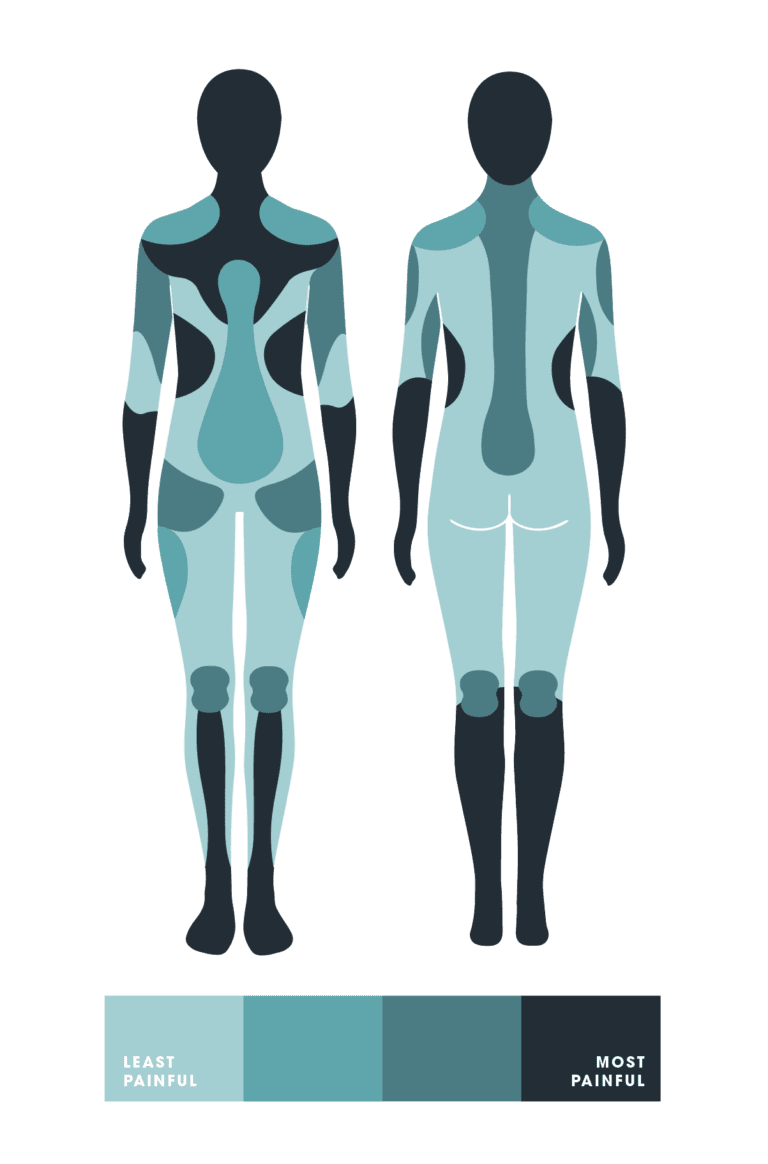

It’s essential to communicate openly with your tattoo artist about any discomfort you experience during the session. They can adjust their technique or take breaks to help you manage the pain. Some artists also offer numbing creams or gels to help alleviate discomfort, although their effectiveness varies.
It’s important to remember that while getting a tattoo can be uncomfortable or painful, it is generally bearable for most individuals. The discomfort usually subsides shortly after the tattooing process is complete. The excitement of having a new tattoo often outweighs the temporary discomfort for many people. If you have a low pain threshold or concerns about pain, discuss your worries with your tattoo artist during the consultation, and they can offer guidance and support to make the process more comfortable for you.
Permanent Tattoos Healing and Aftercare
Proper healing and aftercare are essential for the long-term appearance and health of your permanent tattoo. After getting a tattoo, you need to follow specific guidelines to ensure it heals well and maintains its vibrant colors. Here’s a step-by-step guide on how to care for your new tattoo:
- Follow the Tattoo Artist’s Instructions
Your tattoo artist will provide you with detailed aftercare instructions. These guidelines should be followed carefully. They may have specific recommendations based on their technique and the tattoo’s size and location.
- Keep the Tattoo Covered: Immediately after getting the tattoo, the artist will cover it with a bandage or plastic wrap to protect it from airborne bacteria. Leave this covering on for the time recommended by the artist, typically a few hours to a day.
-
Clean the Tattoo Gently: After removing the bandage, gently wash the tattoo with mild, fragrance-free soap and warm water. Use your clean hands, not a washcloth or sponge. Pat it dry with a clean, lint-free towel.
-
Apply an Antiseptic Ointment: Apply a thin layer of an approved antiseptic ointment recommended by your tattoo artist. Common choices include A&D ointment or specialized tattoo aftercare products. This will keep the tattoo moisturized and protect it from infection.
-
Avoid Excessive Moisturizing: Over-moisturizing can suffocate the tattoo and delay the healing process. Apply a small amount of ointment, and only when the tattoo appears dry or tight. Typically, you should apply it two to three times a day.
-
Avoid Sunlight: Keep the healing tattoo out of direct sunlight and away from UV rays. Sun exposure can cause fading and damage to the tattoo.
-
Avoid Swimming: Stay out of pools, hot tubs, and bodies of water while your tattoo is healing to prevent infection. Soaking the tattoo can cause fading and loss of ink.
- Do Not Pick at Scabs: Your tattoo will go through various healing stages, including scabbing and peeling. Avoid picking at scabs, as this can cause ink loss and scarring.
- Wear Loose, Clean Clothing: While your tattoo is healing, wear loose-fitting clothing that won’t rub or irritate the tattooed area. Make sure your clothing is clean to avoid introducing dirt or bacteria.
- Keep It Clean and Dry: During the healing process, it’s essential to keep the tattoo clean and dry to prevent infection. Avoid submerging it in water, such as in the bath or pool.
- Patience and Care: Healing times vary, but most tattoos take several weeks to fully heal. Be patient and continue to care for your tattoo even after it appears to be healed. This will ensure it looks its best for the long term.
- Consult Your Tattoo Artist: If you have any concerns, complications, or questions during the healing process, don’t hesitate to contact your tattoo artist. They can offer guidance and advice to ensure your tattoo heals correctly.
Proper aftercare is crucial for the appearance and longevity of your permanent tattoo. By following these guidelines and the specific instructions provided by your tattoo artist, you can help ensure that your tattoo heals beautifully and remains a vibrant piece of body art for years to come.
Cost of Tattoo Design in Nairobi, Kenya
Several elements influence how much a tattoo will cost:
- Size of Tattoo: Small → less time, less ink, cheaper. Large (sleeves, back pieces) take more time & cost more.
- Complexity / Detail: Simple line work or script is cheaper. Shading, color, realism, portraits cost more.
- Color vs. Black & Grey: Color inks + shading raise cost. Black/grey tends to be cheaper.
- Placement on Body: Areas that are harder to reach, more painful, or require more care often cost more.
- Artist Skill / Reputation: More experienced artists charge more per hour or for their brand.
- Studio Location & Overhead: Studios in CBD or upscale neighborhoods tend to be more expensive.
- Design Custom vs Flash: Custom artwork often includes design fee and more prep; flash (pre‐existing designs) tends to be cheaper.
Tattoo Design Cost Breakdown Table
Tattoo Size / Tier | Price Range (KSh) | What You Get Included Typically |
Small (e.g. small symbol, initials, wrist/ankle) | 2,000 – 5,000 | Basic line work, simple design, minimal shading, basic ink, 1-hour or less session. Studio hygiene, single-use needles included |
Medium (forearm piece, medium shoulder/back tattoo) | 5,000 – 12,000 | More detail, possibly color, more complex line/shading, maybe 2-5 hours total, custom or slightly modified flash designs. |
Large / Custom (sleeves, large back, chest panels, portrait) | 15,000 – 30,000 | High detail, multiple sessions, high quality inks, color or realism, elaborate design, custom work. |
Hourly Rates for Specialty Styles (dotwork, realism, trash polka, etc.) | 4,000 – 10,000 per hour | Depends on artist prestige, style; specialty styles cost more per hour |
Potential risks associated with Permanent Tattoos
Getting a permanent tattoo is generally safe when done by a professional, in a clean and reputable studio, and with proper aftercare. However, there are potential risks and complications associated with permanent tattoos that you should be aware of:
- Infection: Infections can occur if the tattoo is not properly cared for during the healing process or if unsterile equipment and practices are used during the tattooing process. Symptoms may include redness, swelling, pain, and discharge.
- Allergic Reactions: Some individuals may have allergic reactions to tattoo ink, particularly if they are sensitive to certain pigments or ingredients in the ink. Allergic reactions can manifest as itching, redness, swelling, or rash.
- Granulomas: Granulomas are small bumps that can form around the tattooed area as a reaction to the ink. These bumps are typically benign but can be bothersome.
- Keloids and Hypertrophic Scarring: Keloids are raised, thickened areas of scar tissue that can form around the tattoo. Hypertrophic scarring is similar but less raised. Some individuals are more prone to developing keloids or hypertrophic scars, and this risk may be higher with tattoos on certain body parts.
- Fading and Blurring: Over time, tattoos can fade or lose their sharpness. This is especially true for tattoos exposed to sunlight. Inadequate aftercare, improper ink depth, and low-quality ink can also contribute to fading.
- Ink Migration: Some ink may spread slightly over time, leading to blurred lines or a loss of detail in the tattoo. The risk of ink migration depends on the quality of the tattoo, the skill of the artist, and the placement of the tattoo.
- Regret and Tattoo Removal: People’s tastes and life circumstances can change, leading to regret over a tattoo. Tattoo removal is an option, At Rebel Inks Tattoo Removal and Piercings Parlour we offer the best and most effective Laser Tattoo Removal Procedures that will completely erase the unwanted tattoos, Contact Us Today for further consultation and scheduling.
- Transmission of Bloodborne Pathogens: If the tattoo studio does not follow proper hygiene and sterilization practices, there is a risk of transmitting bloodborne diseases such as hepatitis or HIV.
- Permanent Nature: The very nature of a permanent tattoo means that you’re making a lifelong commitment. While this is the intention for most people, it can be a risk for those who have second thoughts or whose circumstances change.
- Social and Professional Implications: In some cases, tattoos can affect your professional life or interactions with others. Visible tattoos may be subject to dress code policies or cultural biases in certain workplaces.
- Unwanted Cultural or Symbolic Interpretation: Some symbols or designs may have meanings in other cultures that you are unaware of, and your tattoo might be misinterpreted.
To minimize these risks, it’s essential to choose a reputable and experienced tattoo artist, ensure the studio follows proper hygiene and safety practices, and follow the artist’s aftercare instructions meticulously. Additionally, consider your choice of design, placement, and your own personal circumstances before getting a permanent tattoo to reduce the potential for regret or social implications.
Get In Touch
For more information on the list above and any other special services,please call or come in for free consultation
Testimonials
After he pierced my industrial piercing and seeing his amazing work, I feel even more excited about getting my tattoo with him in January. I’m really looking forward to it!
I am extremely happy with my new 'Safari' tattoo from Eric at Rebel Inks! The quality of the artwork is fantastic. Eric is a true professional and an amazing artist.
The preparation and design process was thorough and collaborative. He was very patient with my specific requests, including making sure all the elements, which hold personal meaning, were perfect.
The service was friendly and highly professional from start to finish. Despite the 8-hour session, Eric was a pleasant person to spend the time with.
The aftercare guidance and follow-up have been excellent and careful, which has made the healing process easy and better than expected.
I highly recommend Eric for anyone looking for a thoughtful, talented, and caring tattoo artist.
I recommend them 💯
I would definitely recommend if you’re thinking of getting a piercing!
The staff were super friendly, explained everything clearly, and made me feel so at ease. They answered all my nervous questions (and I had many questions),
They walked me through the whole process, gave detailed aftercare instructions, and even followed up afterward to check how I was healing 🫶
Clean, professional, and full of good vibes.
Would 100% recommend . Definitely making a second trip here.
This was the second tattoo I got and I wish I could have come to Eric for my first one! He gave me really great after-care directions for the tattoo as well as a little jar of his own Vaseline-type stuff to put over my tattoo while it was healing! He even put second skin over my tattoo so that I didn’t have to worry about it for the first few days. Now THAT’S good service. My first tattoo artist didn’t do none of that lol.
After the session Eric didn’t rush me and my friend out, he chatted with us and even when he found out I was an artist too— really encouraged me to keep creating and to find a community of artists to support me. I almost cried because I’ve had such a hard time with my own art the past couple of years, it meant so much to me to have a fellow very talented artist say that to me. 🤍🤍🤍
Eric you’re amazing, don’t ever stop creating and just know you’ve impacted lives all over the world!🫶🏻 thanks so much for everything!!
From the moment I walked in, Eric was professional, welcoming, and attentive. He made sure I was comfortable throughout, provided everything I needed, and explained every step of the process. The tattooing itself was unbelievably smooth - I genuinely felt no pain compared to my previous tattoos over the last 22 years.
Eric also gave me excellent aftercare guidance and products, and thanks to that, my tattoo healed beautifully. The attention to detail, precision, and shading are absolutely stunning. This is hands-down the best tattoo I've ever had, and I will be flying back to Nairobi for any future ink.
If you want incredible art, a professional experience, and a talented artist who truly cares about his clients, Rebel Ink is the place to go!
From start to finish, the service was exceptional. The piercer was professional, knowledgeable, and made me feel completely comfortable. The cleanliness of the place was above and beyond — everything was spotless and hygienic, which really put me at ease. Highly recommend for anyone considering a piercing!
Shout out to Eric😘
We ended up changing the jewelry three times to ensure I had the best fit and avoided any signs of rejection, and he always listened to my suggestions as a client, which I really appreciated. Now, three months in, my piercing is healing beautifully, with no sign of rejection. Highly recommend for anyone who values a piercer who cares about your comfort and healing journey!
What stood out the most was the aftercare Eric checked in with me even three weeks later to see how the tattoo was healing. That kind of follow-up shows how much he truly cares about his work and his clients.
I’m very satisfied and will definitely be coming back for my next piece. Highly recommend!
The piercing wasn't as painful as I had thought and the process was quick and satisfactory. I love it!!!
The piercing is healing well thanks to the aftercare instructions and follow-up. I would highly recommend Rebel Inks
Eric also did a belly button piercing for a friend, guiding her through the process, doing the piercing and then explaining the after care to her.
The shop is on the 3rd floor, with the entrance to the stairs near an alleyway on the left. The shop is perfect size, clean, and attractive looking. The mural is pretty dope.
Thank you for the amazing service! 🔥👅✨
I got piercibgs there and the process was really good. My biggest concern was hygiene but that wasn't an issue at all, they use new needles and they sanitize them.
The service itself was also welcoming.
I was informes of everything i needed to know beforehand.
10/10 would recommend!
Eric was so calm and patient with my almost 2 year old lady. It was such a clean and hygienic process. We will definitely be back for our second rounds of piercings and maybe even another tattoo!
They assess the area before any art and advise one accordingly. They also give one post clean up process and also do a check up after the body art projects. Overall, I loved my experience and I’m hooked. 👍
Will definitely come back next time I’m in town 🙂
He listened to what I actually wanted and made sure he could fit in the time before I flew back home.
The shop is clean & private and is easy enough to find.
Eric has even checked in a couple of times since to make sure all is good.
I would totally recommend Eric! I absolutely love my Elephants!
I had a very easy healing period and always follow up from Eric to check on my progress...I would highly recommend if you are a first timer because from my experience all went very well and attention to detail
Thank you for a good job and looking forward to send all my friends your way
And all the best with the new year 2025!
From the moment I walked in, the staff was super friendly and made me feel at ease. The studio had a clean, professional atmosphere, which immediately put me at ease. My piercer was incredibly skilled and explained every step of the process, ensuring I was comfortable the entire time. The piercing was quick and practically painless, and the aftercare instructions were clear and easy to follow. I can tell they really care about the health and safety of their clients.
Overall, a fantastic experience—I highly recommend Rebel Inks and Tattoos for anyone looking to get pierced or tattooed!
They do follow up after their services
Eric's Studio isn’t just a place to get a tattoo—it’s an experience. The combination of professionalism, artistic talent, and a welcoming environment makes it a standout destination for anyone considering a tattoo.
I highly recommend Eric’s Studio to both first-timers and seasoned tattoo enthusiasts. If you’re looking for a high-quality tattoo and an enjoyable experience, this is the place to go.
I would definitely recommend their services again and again
Thank you Rebel Ink
My piercings are healing ❤️🩹 well
I would 💯 recommend
I will definitely come back for more .
Two, all the equipments he used for the piercings were new and/or sterilised.
Three, the parlour itself was very clean and was up to par with the hygiene standards.
Four, Eric provided effective aftercare instructions, making sure I knew exactly how to take care of my new piercings and he kept in touch and continues to do so, to check on the healing progress.
I highly highly highly recommend this place!!!
Would definitely recommend them to friends and go back for other piercings
Not only was the piercing process smooth, but he also provided thorough aftercare instructions, making sure I knew exactly how to take care of my new piercings. What really impressed me was that he keeps in touch to check on how the healing is progressing – a sign of true care for his clients.
The shop maintains a high standard of hygiene, and the atmosphere is welcoming and comfortable, which really added to the positive experience. I highly recommend this place to anyone looking for a professional and caring experience. I’ll definitely be coming back for any future piercings!
My appreciation for the excellent customer service I received. The follow-ups were prompt, and I truly appreciated the gentleness and professionalism throughout. Thank you!"
"Looking for professional eyebrow microshading removal? Look no further!"
The customer care is top tier 👌🏾👌🏾.
Wonderful place to get tattoos and piercings. 💯💯
Eric goes ahead to follow up on his clients progress and gives good advice each time I reach out to him.
I would recommend Reble tattoos anytime.
Good job bro we really appreciate.
Ohh and the price is very fair.
The environment was clean , procedure was sterile and the jewelry used are of the best quality.
He followed up with me during the healing process, he educated me on what I needed to do for my aftercare.
Eric is confident, skilled , experienced and the best piercer. Highly recommend Rebel inks.✨
Definitely recommend!
Great experience.
Eric definitely know what he is doing .
I got exactly what I wanted 2 tiny tats on the same finger .
He was kind and patient throughout the session.
Healing process has been good .
Aftercare services were given and regular checkups on the healing process were done.
I would 💯recommend.
Eric gave me the best reception as it was my first time there,and made me trust him all the way. I appreciate good services.
There services are also affordable not to forget 😊.
He was also invested in the aftercare and would ensure I follow the do's and don'ts in taking care of the tattoo and ensuring proper healing and maximum ink retention.
Would highly recommend Rebel Inks Tattoos.
Rebel Inks Tattoo offer the best,affordable and quality tattoo removal services.If you have unwanted ink,choose Rebel Inks Tattoo,they're the best of the best and the professionalism is a top notch.They ensure you're free from unwanted ink with their Laser Tattoo Removal Technology...
I did a Laser Tattoo Removal with them and i can attest they're the best....
Kudos Eric...
I highly recommend.
It was a generally good experience with good hygiene during the piercing process and has been a smooth healing process.... 10/10
tips. Highly recommend 👍🏽
100% recommendable.
I was particularly impressed with Eric's attention to hygiene. He thoroughly cleaned the room before I entered, sanitized all of the equipment he would be using, and changed gloves between each ear. This level of cleanliness gave me great confidence in his professionalism.
Eric's commitment to customer service did not end on the day of the piercing. He followed up with me regularly throughout the healing process to ensure that I was following the aftercare instructions and that my earlobes were healing properly.
I highly recommend Rebel Inks to anyone in Nairobi who is considering getting a piercing. Eric is a highly skilled and experienced piercer who takes great pride in his work.
So I Check all the boxes below and more:
Customer Care: ✔️
Professionalism : ✔️
Cleanliness ✔️
Price: ✔️
After care service ✔️
Thanks and good job, Eric
The place is neat and clean and the equipments he used were also fine standards. Really appreciate his following up with me on the healing 🤗
I WOULD HIGHLY RECOMMEND THEIR SERVICES to everyone. Actually what you see on their website is EXACTLY what you will get. Keep up the good work Rebel inks Tattoos.
The infection is now gone. I would definitely recommend!
Can recommend this place totally and would go back there anytime!
Thanks!
OUR LOCATION
Areas We Serve
NAIROBI
KIAMBU
KAJIADO
MACHAKOS

